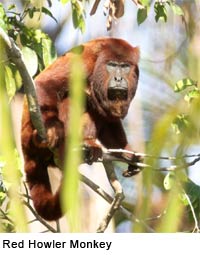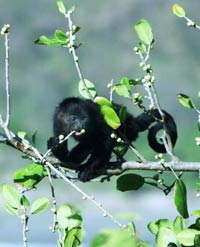|

 Tails like a fifth hand: Howler monkeys range in size from 56 to 92cm, excluding their tail which can be as long as their bodies. Like many New World monkeys, they have prehensile tails that aid them in climbin by wrapping around tree branches; theirs are naked on the underside. Tails like a fifth hand: Howler monkeys range in size from 56 to 92cm, excluding their tail which can be as long as their bodies. Like many New World monkeys, they have prehensile tails that aid them in climbin by wrapping around tree branches; theirs are naked on the underside.
Naked faces: They are the largest of the New World monkeys, and their hair is quite coarse, though their faces are hairless. Their lower necks and jaws are large, and the angle of the lower jaw is what helps them product their extremely loud and resonant calls. Their legs are stout compared to other New World monkeys.
 Not a good pet: While seldom aggressive, they do not take well in captivity and are of a surly disposition, and hence are the only monkey in their forests not made a pet by the Native Americans. Not a good pet: While seldom aggressive, they do not take well in captivity and are of a surly disposition, and hence are the only monkey in their forests not made a pet by the Native Americans.
Whooping and barking: As their name suggests, vocal animal communication forms an important part of their social behavior. Specifically, the name comes from their distinctive loud barking whoop they make, which can be heard over considerable distances. Their calls can be heard 2 miles through a jungle or 3 miles over a lake! They have an enlarged basihyal or hyoid bone which helps them make their loud sound. Unlike other New World monkeys, both male and female howler monkeys have trichromatic color vision.
 Slow and careful: The large slow moving monkeys are the only folivores (leafof the New World monkeys. Howlers eat mainly top canopy leaves, together with fruit, buds, and flowers. They move quadrapedally and do not brachiate, usually holding on to a branch with at least two hands or one hand and the tail at all times. Their prehensile tails are strong enough to support the monkey's entire body weight, although they seldom do so. The first 2 fingers of each hand are set apart and are opposable to the other three. They very seldom leave the trees. Slow and careful: The large slow moving monkeys are the only folivores (leafof the New World monkeys. Howlers eat mainly top canopy leaves, together with fruit, buds, and flowers. They move quadrapedally and do not brachiate, usually holding on to a branch with at least two hands or one hand and the tail at all times. Their prehensile tails are strong enough to support the monkey's entire body weight, although they seldom do so. The first 2 fingers of each hand are set apart and are opposable to the other three. They very seldom leave the trees.
They have a lifespan of 15 to 20 years. These monkeys are native to South and Central American forests. They live in groups of usually about 18 individuals. Threats to howler monkeys include being hunted for food and export.

The Black Howler Monkey (Alouatta caraya) is a species of howler monkey, a large New World monkey, from Argentina, Bolivia, Brazil and Paraguay, being the southernmost member of the Alouatta genus. It lives in groups of 3 to 19 individuals (usually 7 to 9). There are usually 1-3 males for every 7-9 females in a group. When mating, males and females within a single group pair off.
Roaring at Dawn: Named for their vocalizations, they may be heard most often around sunrise. This "dawn chorus" sounds much more like roaring than howling, and it announces the howlers' position as a means to avoiding conflict with other groups. The call can be heard up to 5 km away.
The least active monkey of the New World: These monkeys commonly sleep or rest up to 80% of the day, making it one of the least active monkeys in the New World. Their habitat is forest where they eat mostly leaves, but also will eat the occasional fruit, such as figs. They generally prefer walking and climbing to running or leaping. The prehensile tail is very strong and acts as a fifth limb, allowing the monkeys greater versatility when climbing and allowing them greater safety in the occasional fall from a high branch. Because their limb structure makes terrestrial movement awkward, they spend most of their time in the trees and only come down for water during dry spells. Otherwise the monkeys drink by wetting their hand on a moist leaf and then licking the water of their hand. Their lifespan is up to 20 years, but more commonly 15 years in the wild
Possible Advertisement
.
Family Atelidae
- Subfamily Alouattinae
- A. palliata group
- Coiba Island Howler, Alouatta coibensis
- Alouatta coibensis coibensis
- Azuero Howler Monkey, Alouatta coibensis trabeata
- Mantled Howler, Alouatta palliata
- Guatemalan Black Howler, Alouatta pigra
- A. seniculus group
- Red-handed Howler, Alouatta belzebul
- Brown Howler, Alouatta guariba
- Northern Brown Howler, Alouatta guariba guariba
- Southern Brown Howler, Alouatta guariba clamitans
- Guyanan Red Howler, Alouatta macconnelli
- Amazon Black Howler, Alouatta nigerrima
- Bolivian Red Howler, Alouatta sara
- Venezuelan Red Howler, Alouatta seniculus
- Colombian Red Howler, Alouatta seniculus seniculus
- Alouatta seniculus arctoidea
- Juara Red Howler, Alouatta seniculus juara
- A. caraya group
- Black Howler, Alouatta caraya
- Subfamily Atelinae
Baboon | Lion Tamarin | Marmoset | Mandrill | Patas Monkey| Squirrel Monkey
Primates| Apes| Monkeys| Prosimians
All text is available under the terms
of the GNU Free Documentation License
|